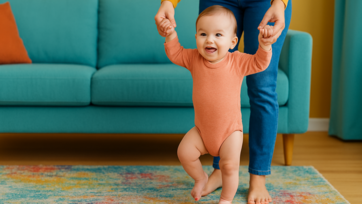How to teach babies

How to Teach Your Baby to Walk
How to Teach Your Baby to Walk – A Detailed Guide for Parents
Your baby's first steps are one of the most magical milestones in parenthood. It marks the beginning of a new era of exploration, independence, and freedom. But how can you support your child in learning to walk in a way that is safe, joyful, and natural?
In this article, we’ll walk you through every step of the process—from early movement development to confidence-building tips and signs to watch for.
1. When Do Babies Start Walking?
Walking doesn’t begin with the first steps—it starts much earlier. Most babies begin to walk independently between 9 and 18 months. However, this range is entirely normal—every child develops at their own pace.
First comes head control, then rolling, sitting, crawling, standing with support, cruising along furniture—and only then, independent walking.
2. Pre-Walking Developmental Stages
Before your baby starts walking, they typically pass through several stages:
Tummy time – from just a few weeks old, it helps strengthen the neck and back muscles.
Rolling, scooting, crawling – these improve balance, coordination, and strength.
Sitting up and sitting steadily – usually develops between 6–8 months.
Pulling up to stand – many babies begin doing this between 8–10 months.
If these steps are progressing well, walking is just around the corner.
3. What Helps Babies Learn to Walk?
a) A Safe Space to Move
Make sure your home has a safe area where your baby can move freely. Remove any sharp or dangerous objects, secure furniture, and ideally use a soft, non-slip rug as their practice zone.
b) Things to Hold On To
Low furniture, couches, stable coffee tables, or walking aids provide opportunities for your baby to practice pulling up, standing, and balancing.
c) Push Toys
Sturdy push toys—like wooden walkers or small wagons—are great for helping babies take steps while giving them some stability and confidence.
d) Barefoot is Best
Let your baby walk barefoot at home. Their feet are full of sensory receptors that help them understand balance and movement. Shoes are only necessary outdoors.
4. Fun Daily Activities That Encourage Walking
Stand Together
Sit on the floor with your baby and offer your hands. Encourage them to pull up or step toward you. You can also use a favorite toy as motivation.
Squat and Call
If your baby is starting to take steps, move a short distance away, squat down to their level, open your arms, and call them with joy: “Come here!” Your face and voice will reassure them.
Sing Movement Songs
Simple action songs like “If You’re Happy and You Know It” or “Walking, Walking” help your baby move in rhythm and build coordination in a fun and loving way.
5. What Not to Do
Don’t force it – every baby develops in their own time. Trying to make them stand or walk too early can cause harm or fear.
Avoid prolonged use of baby walkers – these may hinder natural development of balance and motor control.
Don’t compare with other babies – variations in timing are completely normal.
6. When Should You Be Concerned?
While the walking window is broad, you should talk to your pediatrician if:
Your baby isn’t standing or attempting to cruise by 18 months
Muscle tone seems off – either very stiff or overly floppy limbs
Asymmetrical movement – such as using only one side consistently
These may indicate developmental concerns, and early support makes a big difference.
7. Your Role as a Parent: Encouragement, Patience, and Love
The most powerful thing you can offer your baby is your presence, praise, and belief in them. Your face, voice, and reactions teach them more than words ever could. Celebrate even the smallest tries—they’re steps toward independence.
Sometimes your child may stumble or become discouraged. Stay calm, offer comfort, and encourage them to try again. Their confidence grows from your support.
8. Final Thoughts
Learning to walk is a beautiful journey. Every step, whether tiny or bold, is part of your baby’s path to independence. Don’t rush the process—just be present, both physically and emotionally, as they discover what they’re capable of.
The most magical moments are those we don’t force, but simply witness with love. And your baby’s first steps are exactly that.